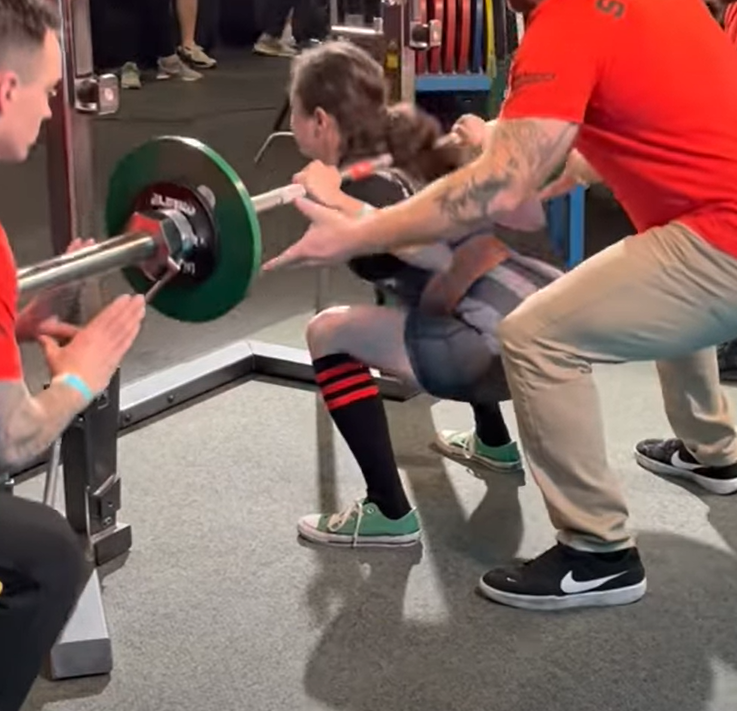Squat is the foundation exercise for strength expression is at the route of force and power production. No matter the age or limitation everyone who can should learn how to squat properly. A proper squat utilizes the biggest and strongest muscles in the body, posterior chain muscular. Learning how to squat properly will greatly improve your quality of life.
Fallon squatting at her first powerlifting meet
Set up - The bar is placed securely on the back, this is done by taking the narrowest grip possible, ideally while keeping the wrist straight and placing the bar just below the spine of the scapula. The spine of the scapula is the boney protrusion at the top of the shoulder blades. When the bar is placed here this is the low bar position. If pain and mobility limitations are restricting, finding a comfortable secure bar placement will suffice.
Walk out - When the bar in in a secured position take a narrow stance, lift the chest is up, keep the lower back neutral, lock it into position by bracing the abdominals and squat the weight up. Balance the body, take ONE BIG STEP BACK, then widen the stance so the feet are shoulder width apart and toes pointing out at 45°. While keeping abdominals tight the lifter, will exhale and then take a big breath the belly and further tightening up the abdominal region. The lifter is balance and leaning slightly forward at the hips
Eccentric – The lifter starts the squat by pushing the knees out and sending the hips back. Making sure the knees are continually being pushed out. This will allow the external rotators of the hip (glute medius minimus and maximus) to co-contract while the hips are place into flexion. Keeping the knees out places the adductors into a stretch position which because they cross the hip joint can aid in hip extension. During the descent the lifter stays braced and balanced. Balanced is having the weight centered though the mid foot.
Bottom – This is a very important spot because it is what will define the end range of motion. If we do not hold to this standard the body will naturally go as deep as it want to potentially leading to an inconsistently high squat.
Proper depth is achieved when the hip crease goes just below the top of the patella. With a proper stance
We want to continue to drive the knees out to clear space to proper depth while allowing the stretched adductors to aid in hip extension.
Fix depth. If depth is an issue (too deep or too high) learning to do box squats with a wider stance just below parallel is the best way to go about fixing this.
Concentric - After the bottom position is reached, the lifter will stand up using “hip drive.” When done right the weight stays over the middle of the foot the knees do not “slide” forward and the back angle stays relatively the same upon ascending. A slight close in back angle is a normal occurrence. After about ½ up they will pull the hip forward and reset for either another rep or rerack.
In conclusion
In a squat we must ensure we using the hips and are getting proper depth. This comes from proper bar placement, stance, and execution. This will allow the hip muscular, to contribute into moving the barbell straight upwards. It is crucial for the liter to continue to keep the weight balanced over the middle of the foot and the torso rigid. If the weight shifts forward through valgus collapse the hamstrings and adductor contribution to the lift is depreciated and it may also prevent the lifter from hitting proper depth.
It is just as important to the lift to understand and visualize the execution of the lift. Commit to memory the phases of the lift and visualize yourself performing it. This is the image you’ll refer back to every time you squat. Always revisit your trusted resources.

